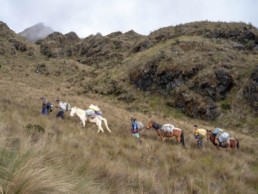...complex...

...pressing...

...too important to ignore.

If the scale of global warming feels overwhelming, you’re not alone. Throughout most of our evolution, humans have adapted to hunting, gathering, and navigating social dynamics within small communities. The challenge of managing a planetary-scale, interconnected industrial civilization and its ecological repercussions is way beyond the scope our brains have evolved to deal with.
Contrary to what our intuitions might tell us, the increasing concentrations of greenhouse gases don’t simply correspond to a gradual increase in temperatures and therefor gradual ecological, social and economic consequences. Crossing ecological tipping points that would result in sudden, severe and irreversible consequences. Climate action needs to swift, effective and at large scale.
We find ourselves in a moment of human history where our collective an individual actions have an unprecedented impact on the future of humanity and of the entire biosphere. The greenhouse gases we emit today will linger in the atmosphere for hundreds or thousands of years and will shape the climate of the planet long after we’re gone.
So, what do we do?
Allowing damaged forests to grow back in addition to halting deforestation can reduce almost
30%
of global carbon emissions.
Amidst the depressing news that we humans are not on track to meet the goals we set for ourselves at the Paris Climate Conference, there is still some good news to be had. By working to halt deforestation in our efforts to protect the planet’s biodiversity, we are also helping to lock up the billions of tons of carbon that is stored in rainforests. And these forests are the original – and most cost effective – method of carbon capture and sequestration. In addition to locking up the carbon in standing forests by conserving them, the natural regeneration of forests and restoration of degraded areas is removing carbon from the atmosphere. Net deforestation accounts for about 10% of global carbon emissions. But, allowing damaged forests to grow back in addition to halting deforestation can reduce almost 30% of global carbon emissions.
Forests are a mitigation approach that can actually achieve negative net emissions.
Our work to reduce tropical deforestation and emissions is a bargain in the fight to control global climate change. Protecting tropical forests is among the quickest and most affordable ways to decrease emissions, while also advancing development. Standing tropical forests contribute to the achievement of Sustainable Development Goals related to health, food, water energy, human safety and biodiversity.
Mangroves' Hidden Power in Carbon Storage

Mangroves are a type of tropical forest found at the edge of land and sea, regularly flooded by tidal waters. They are among the most carbon-rich forests in the tropics, with carbon sequestration rates two to four times higher than those of mature tropical forests. Unfortunately, mangrove deforestation continues, contributing to increased carbon emissions and the loss of biodiversity. Our partners Fishing Cat Ecological Enterprise in Cambodia are working to protect and restore these vital ecosystems.
Kayapo Guardians: Protecting Vast Carbon Stores

Large-scale conservation of intact forests is crucial for climate mitigation, and the Kayapo are a perfect example. Their five ratified Indigenous territories, spanning 10.6 million hectares and containing an estimated 1.9 billion tonnes of forest carbon, are located in the Xingu basin of southeastern Amazonia, Brazil. As our Indigenous partners, the Kayapo’s conservation model is a powerful example of successful efforts at the frontlines of deforestation.
Adaptation
Healthy forests help people and other species adapt to the effects of a warmer planet.
They increase climate resilience by improving food and water security, improving air quality, reducing damage from increasingly stronger storms by protecting coastlines and reducing erosion and run-off.


To help flora and fauna adapt to what is already a warmer world, conservation groups must focus on strategies that enable eventual migration up slope to higher elevations or to cooler latitudes. Linking lowlands to intact protected areas in mountain ranges via protected biological corridors is a way to lesson extinction risk for at least some species.
